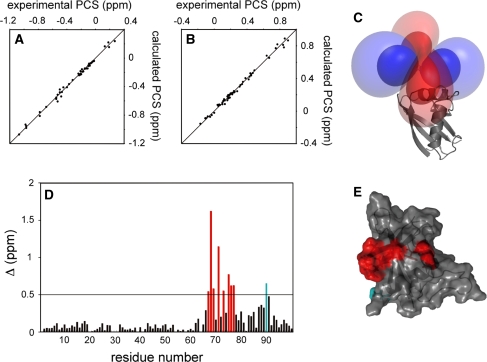Fig. 3.
Input parameter determination for the docking calculation. a and b Comparison of experimental and back-calculated PCSs of backbone amide protons observed for 15N-labeled LBT-DR/unlabeled KE in complex with Tb3+ (a) and Tm3+ (b). The tensors were calculated using the monomer structure of DR. The ideal correlations are indicated. c View of the experimentally determined isosurfaces corresponding to a PCS of ±4.6 and ±1.2 ppm, respectively. Positive and negative PCS values are indicated by blue and red, respectively. d Chemical shift perturbation of the backbone amide groups of KE upon complex formation with LBT-DR at a ration of 1:1. Δ (ppm) was defined as ((Δ1HN)2 + (Δ15N/5)2)1/2 and plotted against the residue number of KE. The residues with Δ (ppm) > 0.5, except for Asp90, are shown in red. Asp90, which showed a chemical shift change larger than 0.5 ppm but was not used as a contact surface restraint as it did not satisfy the inclusion criteria, is shown in cyan. e The mapping of the results with large chemical shift changes on the structure of p62 PB1. Residues are colored according to the color codes used in (d)

